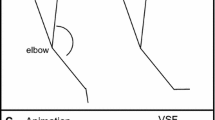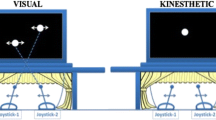Abstract
The learning of relative and absolute motion features as a function of physical (actor group) and observational (observer group) practice was examined in a rhythmic single limb multi-joint coordination task. The task required the participants to learn a 90° relative phase pattern between the elbow and wrist in combination with an absolute elbow joint angle of 80° and a wrist joint angle of 48°. Each actor practiced the required relative and absolute motion features for 2 days while being watched by an observer. Overall, the actor group was characterized by an improvement in performance on the relative phase component and showed a clear differentiation in joint amplitudes. In a 24-h retention test, the observer group more closely matched the performance of the actors on the relative phase component in comparison to a control group that was not exposed to physical or observational practice. However, the observer and control groups did not demonstrate a clear differentiation in required joint amplitudes. In agreement with Scully and Newell (1985), we conclude that relative phase may be classified as a relative motion feature that may be picked through observation and benefit initial physical performance, whereas the joint amplitudes may be classified as absolute motion features that require physical practice to achieve the appropriate scaling.




Similar content being viewed by others
Notes
Even though the required wrist amplitude for the IP and AP templates was 80°, we computed the IP and AP wrist amplitude errors based on the vertical ellipse template goal to highlight the differences in wrist amplitude across the three templates and the three participant groups.
The learning trends exhibited by the actors in this experiment were very similar to the trends reported in Buchanan et al. (2007). For this reason, we select only the first and last block of practice to show the change in performance of the actor group with regard to the relative and absolute motion features. The variable Training arm (dominant or non-dominant) was not a significant factor regarding the performance of the observation and control groups and has been dropped as a variable from all the analyses. The impact of training arm on the performance of the actor group was consistent with those reported in a different manuscript (see Buchanan et al. 2007).
References
Al-Abood SA, Davids K, Bennett SJ, Ashford D, Marin MM (2001) Effects of manipulating relative and absolute motion information during observational learning of an aiming task. J Sports Sci 19:507–520
Amazeen PG (2002) Is dynamics the content of a generalized motor program for rhythmic interlimb coordination. J Motor Behav 34:233–251
Ashford D, Davids K, Bennett SJ (2006) Observational modeling effects for movement dynamics and movement outcome measures across differing task constraints: a meta-analysis. J Motor Behav 38:185–205
Badets A, Blandin Y, Shea CH (2006) Intention in motor learning through observation. Q J Exp Psychol 59:377–386
Bingham GP (2004) A perceptually driven dynamical model of bimanual rhythmic movement (and phase perception). Ecol Psychol 16:45–53
Bingham GP, Schmidt RC, Zaal FTJM (1999) Visual perception of the relative phasing of human limb movements. Percept Psychophys 61:246–258
Black CB, Wright DL (2000) Can observational practice facilitate error recognition and movement production. Res Q Exerc Sport 71:331–339
Black CB, Wright DL (2001) Can observational practice facilitate error recognition and movement production. Res Q Exerc Sport 71:331–339
Black CB, Wright DL, Magnuson CE, Brueckner S (2005) Learning to detect error in movement timing using physical and observational practice. Res Q Exerc Sport 76:28–41
Brown LE, Wilson ET, Billing RS, Obhi SS, Gribble PL (2007) Motor-learning-by-observing without observing learning. Society for Neuroscience, San Diego
Buchanan JJ (2004) Learning a single limb multi-joint coordination pattern: the impact of a mechanical constraint on the coordination dynamics of learning and transfer. Exp Brain Res 156:39–54
Buchanan JJ, Kelso JAS (1993) Posturally induced transitions in rhythmic multijoint limb movements. Exp Brain Res 94:131–142
Buchanan JJ, Kelso JAS, deGuzman GD (1997) Self-organization of trajectory information. Biol Cybern 76:257–273
Buchanan JJ, Zilhman K, Ryu YU, Wright DA (2007) Learning and transfer of a relative phase pattern and a joint amplitude ratio in a rhythmic multijoint arm movement. J Motor Behav 39:49–67
Burgess-Limerick RJ, Abernethy B, Neal RJ (1991) Note: a statistical problem in testing invariance of movement using the phase plane model. J Motor Behav 23:301–303
Carroll WR, Bandura A (1982) The role of visual monitoring in observational learning of action patterns: making the unobservable observable. J Motor Behav 14:153–167
Carroll WR, Bandura A (1985) Role of timing of visual monitoring and motor rehearsal in observational learning of action patterns. J Motor Behav 17:269–281
Carroll WR, Bandura A (1987) Translating cognition into action: the role of visual guidance in observational learning. J Motor Behav 19:385–398
Carson RG, Thomas J, Summers JJ, Walters MR, Semjen A (1997) The dynamics of bimanual circle drawing. Q J Exp Psychol 50A:664–683
Coren S (1993) The lateral preference inventory for measurement of handedness, footedness, eyedness, and eardness. Norms for young adults. Bull Psychon Soc 31:1–3
Cutting JE, Proffitt DR (1982) The minimum principle and the perception of absolute, common, and relative motions. Cognit Psychol 14:211–246
Dounskaia NV, Swinnen SP, Walter CB, Spaepen AJ, Verschueren SMP (1998) Hierarchical control of different elbow–wrist coordination patterns. Exp Brain Res 121:239–254
Fontaine RJ, Lee TD, Swinnen SP (1997) Learning a new bimanual coordination pattern: reciprocal influences of intrinsic and to-be-learned patterns. Can J Exp Psychol 51:1–9
Haken H (1983) Synergetics. Springer, Berlin
Haken H, Kelso JAS, Bunz H (1985) A theoretical model of phase transitions in human hand movements. Biol Cybern 51:347–356
Hodges NJ, Chua R, Franks IM (2003) The role of video in facilitating perception and action of a novel coordination movement. J Motor Behav 35:247–260
Hodges NJ, Franks IM (2000) Focus of attention and coordination bias: implications for learning a novel bimanual task. Hum Mov Sci 19:843–867
Hodges NJ, Franks IM (2001) Leaning a coordination skill: interactive effects of instruction and feedback. Res Q Exerc Sport 72:132–142
Hodges NJ, Franks IM (2002) Learning as a function of coordination bias: building upon pre-practice behaviours. Hum Mov Sci 21:231–258
Hodges NJ, Williams AM, Hayes SJ, Breslin G (2007) What is modelled during observational learning? J Sports Sci 25:531–545
Huys R, Williams AM, Beek PJ (2005) Visual perception and gaze control in judging versus producing phase relations. Hum Mov Sci 24:403–428
Johansson G (1973) Visual perception of biological motion and a model for its analysis. Percept Psychophys 14:201–211
Kelso JAS (1984) Phase transitions and critical behavior in human bimanual coordination. Am J Physiol (Reg Integ Comp) 15:R1000–R1004
Kelso JAS (1994) The informational character of self-organized coordination dynamics. Hum Mov Sci 13:393–413
Kelso JAS (1997) Relative timing in brain and behavior: some observations about the generalized motor program and self-organized coordination dynamics. Hum Mov Sci 16:453–460
Kelso JAS, Buchanan JJ, Wallace SA (1991) Order parameters for the neural organization of single limb, multijoint movement patterns. Exp Brain Res 85:432–445
Kelso JAS, Pandya AS (1991) Dynamic pattern generation and recognition. Morgan Kaufmann, San Mateo
Kelso JAS, Scholz JAS, Schöner G (1986) Nonequilibrium phase transitions in coordinated biological motion: critical fluctuations. Phys Lett A 118:279–284
Kelso JAS, Zanone PG (2002) Coordination dynamics of learning and transfer across different effector systems. J Exp Psychol Hum Percept Perform 28:776–797
Lee TD, Swinnen SP, Verschueren S (1995) Relative phase alterations during bimanual skill acquisition. J Motor Behav 27:263–274
Mardia KV (1972) Fundamentals of experimental design. Allyn and Bacon, Boston
Mattar AAG, Gribble PL (2005) Motor learning by observation. Neuron 46:153–160
Schmidt RC, Carello C, Turvey MT (1990) Phase transitions and critical fluctuations in the visual coordination of rhythmic movements between people. J Exp Psychol Hum Percept Perform 16:227–247
Schmidt RC, O’brien B, Sysko R (1999) Self-organization of between-persons cooperative tasks and possible applications to sport. Int J Sport Psychol 30:558–579
Scholz JP, Kelso JAS (1989) A quantitative approach to understanding the formation and change of coordinated movement patterns. J Motor Behav 21:122–144
Scholz JP, Kelso JAS, Schöner G (1987) Nonequilibrium phase transitions in coordinated biological motion: critical slowing down and switching time. Phys Lett A 123:390–394
Schöner G, Haken H, Kelso JAS (1986) A stochastic theory of phase transitions in human hand movement. Biol Cybern 53:247–257
Schöner G, Kelso JAS (1988a) Dynamic pattern generation in behavioral and neural systems. Science 239:1513–1520
Schöner G, Kelso JAS (1988b) A synergetic theory of environmentally-specified and learned patterns of movement coordination. I. Relative phase dynamics. Biol Cybern 58:71–80
Schöner G, Zanone PG, Kelso JAS (1992) Learning as change of coordination dynamics: theory and experiment. J Motor Behav 24:29–48
Scully DM and Newell KM (1985) Observational learning and the acquisition of motor skills: toward a visual perception perspective. J Hum Mov Stud 11:169–186
Shea CH, Wulf G, Park JH, Gaunt B (2001) Effects of an auditory model on the learning of relative and absolute timing. J Motor Behav 33:127–138
Turvey MT (1990) Coordination. Am Psychol 45:938–953
Vogt S (1995) On relations between perceiving, imagining and performing in the learning of cyclical movement sequences. Br J Psychol 86:191–216
Vogt S, Thomaschke R (2007) From visuo-motor interactions to imitation learning: behavioural and brain imaging studies. J Sports Sci 25:497–517
Wilson AD, Collins DR, Bingham GP (2005) Human movement coordination implicates relative direction as the information for relative phase. Exp Brain Res 165:351–361
Wimmers RH, Beek PJ, Van Wieringen PCW (1992) Phase transitions in rhythmic tracking movements: a case of unilateral coupling. Hum Mov Sci 11:217–226
Zaal FTJM, Bingham GP, Schmidt RC (2000) Visual perception of mean relative phase and phase variability. J Exp Psychol Hum Percept Perform 26:1209–1220
Zanone PG, Kelso JAS (1992) The evolution of behavioral attractors with learning: nonequilibrium phase transitions. J Exp Psychol Hum Percept Perform 18:403–421
Zanone PG, Kelso JAS (1997) Coordination dynamics of learning and transfer: collective and component levels. J Exp Psychol Hum Percept Perform 23:1454–1480
Author information
Authors and Affiliations
Corresponding author
Rights and permissions
About this article
Cite this article
Buchanan, J.J., Ryu, Y.U., Zihlman, K. et al. Observational practice of relative but not absolute motion features in a single-limb multi-joint coordination task. Exp Brain Res 191, 157–169 (2008). https://doi.org/10.1007/s00221-008-1512-8
Received:
Accepted:
Published:
Issue Date:
DOI: https://doi.org/10.1007/s00221-008-1512-8




